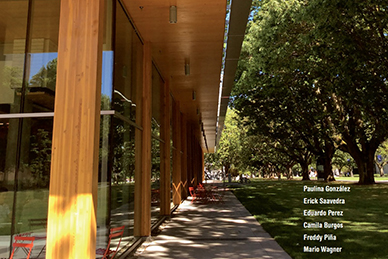Cross-laminated timber offers some extraordinary advantages for buildings: thermal insulation, seismic properties, good performance under fire and ecological sustainability are some of its properties. This was shown by the study led by Paulina González, professor at the Department of Civil Works Engineering. On May 18th, the book with the results of the study was launched.
An innovating system for constructing buildings with more than two floors using cross-laminated timber (CLT) was proposed by an outstanding study led by Paulina González, professor at the Department of Civil Works Engineering.
Cross-laminated timber is a three-layered panel made of lumber. The layers are laid in parallel formation and are “bonded together with special glues, at 90º to the layer below,” Paulina González says. “This gives the panel a high resistance, because wood has different mechanical and physical properties in the three directions,” she adds.
This technology proposed by professor González has already been implemented in other countries; the difference is that, in Chile, it would be based on radiata pine, which forestry is highly developed in Chile.
Professor González says that Chile is among the countries with the largest planted areas of radiata pine. “In addition to developing this project, we can give value added to our timber, try to solve the housing shortage of our country, and establish a system that would allow constructing buildings which structural elements, walls and slabs are made of this new product,” she adds.
Better properties
According to her research, constructing a cross-laminated timber-based building has many advantages over constructing with other materials, like reinforced concrete; For example, as it is a prefabricated product, it allows reduced construction times and a cleaner environment.
“You bring the walls and slabs and assemble the building like a meccano set. It reduces construction times to a third, if compared to the construction of a reinforced concrete building,” she explains.
Besides, cross-laminated timber has seismic properties. As reinforced concrete weighs as much as six times as cross-laminated timber, it generates higher seismic forces than the ones of a CLT-based building. “As it (a CLT based building) is assembled like a meccano set, with steel connectors, it gets so flexible that prevents its destruction,” professor González adds.
Additionally, when constructing a building with CLT, less time is required, what can eventually lead to a solution for reconstruction works after natural disasters.
“Construction times are reduced to a third. And so are the costs. The costs of structural work get reduced by 35%, and the total cost, after installations, to 10%,” she says with regards the economic benefits of CLT.
Radiata pine, the base of the product studied by professor González, is ecologically sustainable. On the one hand, because its carbon footprint- the total amount of greenhouse gases that it emits- is very low; and on the other, because this tree grows very fast and it has extensively been planted in the country.
“It is sustainable because carbon remains in the timber, and the carbon footprint is almost zero. Also, radiata pine grows very fast. This is why there are so many plantations in Chile.”
A safe material
“Depending on its density, when timber burns, it produces a charcoal layer in the outside that works as insulation to prevent fire and heat from entering its inner part,” professor González said, debunking the myth that this material is fragile.
“It will last longer, even longer than a steel building. The steel building’s ability to resist fire is reduced to a half when it is exposed to 400º C. Timber remains stable for its charcoal layer,” she adds.
Besides, timber has better acoustic insulation properties than reinforced concrete.
CORFO Project
The CORFO Project 12BPC2-13553 “Estudios de Ingeniería para Introducir en Chile un Sistema Constructivo de Rápida Ejecución para Edificios de Mediana Altura, Utilizando Elementos de Madera Contralaminada” lasted for two years; however, researchers at the Faculty of Engineering had conducted former studies on this subject matter. For this reason, after all this process, “we concluded that, considering the use of timber, CLT is the best system for a seismic country,” professor González says.
“We have been the first ones in developing a project like this in Chile, with this system for medium-rise buildings,” she says.
Professor González is optimistic about the future that TLC may have in our country due the experiences in other countries of the world. “In Vancouver (Canada), they are designing an eighteen-floored building and organizing a contest to build a 30-floored one,” she explains.
Based on this study, the book ‘Sistema Constructivo en Madera Contralaminada para Edificios’ was produced. It includes former studies on this subject matter and an outstanding model of a four-floored CLT-based.
The book was launched on May 18th, at 12:00 h, in a ceremony at the Salón de Honor of Universidad de Santiago, with the presence of President Juan Manuel Zolezzi Cid.
Translated by Marcela Contreras
Noticias
19 May 2015



